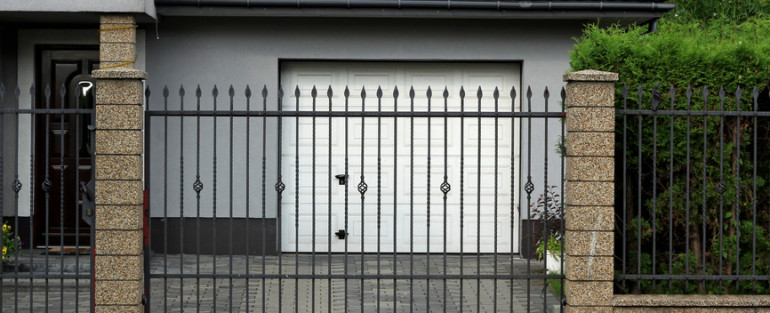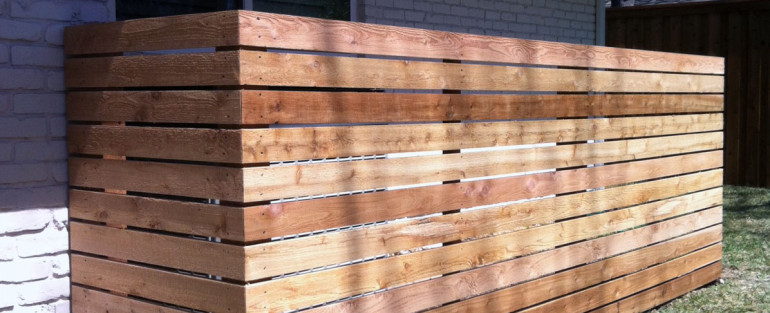
Benefits of Privacy Fencing and Automated Gate-Controlled Entry
One effective way to protect a home and add value to the property in the process is by installing a fence around the property and adding an automatic gate to keep unwanted visitors from coming on your property, while allowing the people inside to control entry through the gate. A fence around your property will give you privacy, something Texas homeowners need and want as part of their outdoor living experience. When you install an automated gate, the added security not only benefits you and your family; it also increases the value of your home and surrounding property.
Deciding What You Need
If you want to use an automated gate to add to your home’s security, you have many alternatives from which to choose. The automatic gate can be an extension of a privacy gate, or one that merely blocks off entry to your property, or just to your house. In today’s technology-driven world, people are looking for ways to transform their homes into smart homes that are easily controlled from every electronic device they own – no matter where they are.
Many homeowners choose to use wireless keypads or telephone systems. With each of these technologies, a person must contact the homeowner via the telephone system or intercom to ask entry or get the keypad code. If homeowners have a whole house security system, it may be possible to remotely program the gate so that it is tied into the entire household security system.
Regardless of the type of technology you choose, and the cost of installing and maintaining it, the goal is keep intruders out and control who enters your property, or the area you choose to surround with an automated gate.
Automated Gate-Entry to Safety-Proof Swimming Pool Accessibility
Homeowners who install an automated gate as part of a fence surrounding a swimming pool, may add a level of security to their pool area with potentially life-saving benefits. Whether the gate has a keypad that only gives entry to people who know the code, or is hooked to a telephone system where people must ask to enter the pool area, this automation may effectively prevent children from entering the pool area without adult supervision.
When it comes to your home’s security, think of the safety of your family. Look at all the materials and options available to you, and allow the experts at L & C Fence & Gate help you choose the automated gate that is as attractive as it is functional. You don’t have to sacrifice looks to increase your home’s security.

Advantages of a Deck
Decks are relatively inexpensive compared to whole room additions, and deck sizes, shapes and materials are easy to customize. Whether you want to create an outdoor entertaining space, complete with built-in seating, or a small area where you can set up your own Texas-style barbecue station, all of this is possible with a deck.
If you have to walk down stairs to enter your backyard, why not take advantage of the elevation to create a living space from which the stairs extend? If your yard or garden area is largely shaded, a deck may allow you to capture some sun so you can grow things to increase the appeal of your outdoor living area. A deck is an excellent place on which to place containers for growing everything from native flowers to vegetables, miniature fruit trees and other interesting plant life.
The materials from which decks are made are easy to care for and need very little maintenance. Railings can increase the privacy of your deck, give you areas on which to place window boxes and offer protection for your children, so you don’t have to worry about whether they will fall. Stone or concrete patios are much more susceptible to damage from weather, and the cost of repairing and maintaining them is considerably higher than it would be for a deck.
You may not be considering selling your home at the moment, but that doesn’t mean that when you make improvements to your home, you shouldn’t consider the value that those improvements add to your home and property. Since outdoor living is so much a part of Texas life, by adding a deck, you are making your home that much more appealing to potential buyers, whether now or years from now.
Why an Arbor?
An arbor or pergola is an excellent way to extend growing space, especially if your property doesn’t have a lot of outdoor space. You can also use it as an umbrella or canopy under which you can put an outdoor living space, eating area, or small sitting area that is shaded from the intense Texas sun and heat. If you have a very sunny outdoor area that extends right off your house, an arbor is a useful and attractive way to shade your house, while also adding visual appeal to your home and to the overall look of your outdoor space.
Fast-growing vines easily attach themselves to arbors, creating a living umbrella that is as attractive as it is functional. If you choose to grow vines that produce colorful nectar-rich flowers, you’ll enjoy your property even more because of the beautiful hummingbirds and butterflies that will be drawn to your arbor. If your arbor is close enough to your home to offer protection from the sun during the hottest part of the day, you may also lower your cooling costs, making the investment of an arbor even more worthwhile.
Whether you add an arbor or a deck to your property, your family will enjoy the added outdoor space, while you increase the overall value of your property, adding to the equity you get from home ownership.

Every fence contractor in Dallas knows that ants swarm in spring. Even worse this year, there is a foreign ant invasion spreading throughout the southeast, replacing local ant populations. These “crazy ants” build colonies 100 times bigger than regular ants, outside and inside houses, in traditional ant locations and in protected areas, like walls and sometimes electronic equipment. Property owners have found them in basements and crawl spaces, air conditioners and computers, and outside in leaf piles and pool pumps. The crazy ant does not respond to regular ant poisons and has no local predators, although it does compete with fire ants.
Texas A&M has identified these ants as Nylanderia fulva, from the area around the border of Brazil and Argentina, according to PLOS ONE online. The Texan invasion apparently started in the ports of Houston, carried there in cargo from South America or Florida, where it is known as the Caribbean crazy ant. It can now be found throughout the southeastern United States.
Crazy ants are about the size of fire ants, but a lighter brown and dull, due to the hair on their stomachs. Rather than marching in straight lines, they run scattered every which way, taking over the living spaces and food sources of local ants, driving them out. They also eat ladybugs and bees. Inside electrical equipment, they cause shorts with the bridges they build between electrical contacts. The ant does not fly during swarming. Colonies spread by inadvertent carriers like cargo boxes, RVs, hay bales, and nursery plants.
N. fulva is now known to be living in at least 21 counties in southeast Texas, as far north as Austin. No one has reported them in Dallas yet, but the Texas Department of Agriculture expects it to be only a matter of time. They and the USDA have deemed the infestation alarming enough that they have set up a special task force to find a way to control the ant and prevent its spread.
Meanwhile, property owners can do their own prevention. L&C Fence & Gate notes that if the colonies start in moist debris piles outside, cleaning up piles can be key to stopping them, especially around the edges of automatic gates, where leaves collect, and in the gate tracks. And if the ants invade enclosed spaces like electronic equipment, then gate gear boxes and pool pumps can be kept cleaned and oiled as a possible deterrent. Although these steps will not stop the ants, they may slow them down enough to at least keep them outside, until researchers can find a longer term solution.

A fence serves a variety of purposes whether it’s using wooden panels for the optimum in privacy, wooden picket fences for a decorative effect or sturdy wrought iron fences for security and enhancement of the home’s exterior and landscaping. Whichever type chosen, periodic maintenance is necessary to keep the fence in shape and looking good.
Wooden Fences
Wooden fences come with several maintenance issues that homeowners should be aware of when choosing this material. Installing a quality fence from the start using the right materials along with standard maintenance can prolong the life of the fence for many years. Consider these tips to maintain a new or existing wooden fence.
● Material – if you are anticipating having a new wooden fence installed, select an appropriate type of wood and ensure the material is labeled pressure treated if it is going to be in contact with the ground. The specific chemicals added to create pressure treated wood protect the fence against moisture and insects especially the posts going directly into the ground that are most susceptible to moisture. Two materials that are good choices for fences as they are resistant to the elements that cause rot and decay and do not need to be pressure treated are cedar and redwood.
● Wood rot and drying – if the wooden panels have not been pre-treated, water from rain and sprinklers will speed up the rotting process. Natural drying and splitting of the wood also takes place over time. These same issues can affect pre-treated panels if not maintained. To prolong the durability of the fence, apply a quality, water-repelling acrylic or oil-based staint to clean, dry panels.
● Vines and foliage– if allowed to grow on or up against untreated wood, plants, shrubs and vines can cause wood rot due to moisture in the plants and a lack of adequate sunlight to keep panels dry. Place plants far enough from the paneling to allow sufficient air flow and sunlight and prune periodically.
● Algae – a natural growth but one that affects the panels. The easiest way to remove algae is with a pressure washer. The force of the water removes the unsightly growth leaving the wood looking like new. Homeowners can rent a pressure washer and do the project themselves or hire a company to do the cleaning. Reapply a coat of water-repelling sealant to the fence once the panels are thoroughly dry. Follow the product instructions for frequency of application.
Wrought Iron Fences
Wrought iron fences provide security while maintaining the open look of your yard. Although sturdy, maintaining the fence helps prevent rust and chipping.
Unlike wooden panels that turn grey and weathered looking if not maintained due to moisture, wrought iron fencing deals with unattractive rust. The build-up detracts from the look of the fence and if left unattended, can weaken the metal.
● Cleaning – clean the fence regularly using a solution of soapy water and a sponge. Visually check for signs of rust and paint bubbling while cleaning.
● Rust removal – for small areas, use a wire brush to scrape rust away from the affected area. After scraping, wipe the entire area down with a damp cloth using the soapy water solution to remove rust residue and debris. Allow fence to dry naturally or wipe it down with dry rags. Apply a metal primer to the clean area according to manufacturer instructions followed by a coat of rust-resistant paint.
● Minor scratches – For minor scratches, use steel wool to work out the scratch then thoroughly clean the area. Let dry then apply several coats of rust-resistant paint to the area.
● Large rust spots – when large or multiple rust spots are detected; it may be time for a complete overhaul of the fence. This entails scraping, cleaning and drying all parts of the fence, applying rust-resistant metal primer followed by a coat, or two, of rust-resistant metal paint.
● Bubbling or flaking paint – if detected, remove it with either a hand held rotary tool and grinder or a wire brush. Sand it down to the bare metal and use a metal filler to address any pitting or holes in the surface. Once dry, clean the fence, dry again then apply a rust-resistant primer followed by two coats of rust-resistant paint to the sanded area.
● Hinges and latches – carefully inspect these areas as both can trap water resulting in rust.
● General care – Keep hedges, vines, shrubs, grasses or any other decorative plants away from the fence to eliminate trapped moisture. Also, keep direct contact with water sprinklers to a minimum.

Your property is a huge investment and it is only natural that you want to protect and beautify it. Having a fence installed is an essential step in security and a large investment for an owner. Choosing the right fence contractor for the job is vital to prevent complications from developing at any point during, or following, the installation.
There are seven basic approaches that can protect you, your property, and your investment.
Research
Before interviewing any fence contractor you can learn a great deal about the individual or company that you are dealing with through your first encounter. Here are a few things to be concerned with:
● When you call the office, there should never be a generic answer to the call. Any professional company will have a professional answer to their phones which should include the name of the company.
● Any advertising should include a verifiable address. Many fly-by-night services will not have a legitimate address to be traced to.
● Never hesitate to check listings with the Better Business Bureau. This is a free service to aid consumers.
● While it is an initial jerk reaction for individuals who are looking at listings to select the first company they come to. Keep in mind that a company that is listed at the top of a search or a phone list, is not an indicator of their ability.
Red Flags for Interview
As you work through the process of finding your contractor some additional items you should keep in mind include:
● A contractor which requires you make an immediate decision should make you nervous.
● Anytime a professional pressures you to pay cash is never a good sign. There are some legitimate businesses which will provide their customers with a cash discount, which should not be confused with the contractor which requires you to pay cash only.
● Any professional contractor will give you a written estimate for the services you are requesting, if they will not give you one, you do not want to do business with them.
Necessary Questions
Some other details to bring up as you speak with your fence contractor, or potential contractor include:
● What materials do they recommend and why?
● If you are replacing, or repairing your fencing ask what their procedures include.
● What is the track record for the contractor staying within the estimate amount?
● How often do they finish on time?
● Is there any type of warranty on the work they provide?
● Will any of the materials you currently have be able to be used or recycled in the installation/repair?
Always speak to multiple contractors and get their written estimates.
Planning 1-2-3
1. As you make your plans for your fence you will need to make an assessment of how much you are willing to spend for the materials and labor. Once you have made these decisions you will need to share the information with the fence contractor and then confirm that they will be able to work within these guidelines.
2. Determine where you want your fence to run. Will it incorporate the entire land or only a portion? Do you want to include different types of fencing, such as one close to the residence and a different form further away.
3. Look at magazines and other properties to get an idea of what you want, give the pictures to the fence contractor to develop a clear idea of what you want. Never be shy about asking for design ideas or help.
Establish Timeline and Contact Person
As you move forward, you will want a definitive timeline of when the work is expected to be completed. Determine if there will be any discounts for delays or inability to reach the set goals.
On large jobs there are often multiple people that will be accomplishing the work, find out who the direct responsible is, in the event of any problems or questions.
Guarantees
Some contractors will provide a guarantee on their work. Ask about any guarantees that the company provides for the job.
Depending upon the materials you select for your fencing, there may also be a warranty on it. Many manufacturers of automatic gates often offer extended warranties of up to 7 years.
Payment
You will need to ask what the company policy is regarding the work. Some companies require full payment up front, others partial payment, or at the end of the job.
Will they finance? Do they accept credit cards, and which ones?

As spring rolls around there is always a long list of things that need to be addressed to get taken care of for the new year. House repairs and maintenance, even lawn care. People often forget about the needs of their fence. No matter what the materials are that you choose to use in the fence structure, whether it is automated or manual, there are a few things to do which will extend the life of your investment.
Your first step is to always do a thorough inspection of the entire fence. You need to look for any areas that are compromised, which may include rot, damage, leaning, and weak points. This includes the posts, pickets, wiring, and gate closure or function. Be aware of any places where the screws, wiring, or nails need to be replaced or tightened.
Once you have performed your inspection you will need to make the necessary plans to repair or replace any areas that are no longer stable. Addressing larger sections and posts may require professional assistance to prevent damaging other sections.
If your fence includes brick and mortar you will need to look for any cracks that have developed or any locations where the stone or brick has come loose. Depending upon the size of the crack, you can often fill this in yourself, however, larger problems should be taken care of by a professional.
We do not recommend adjusting or repairing any electrical features, such as lighting affixed to your fence. This might turn into a dangerous exercise and it is easier to have someone with experience take care of this.
When it comes to gates you need to pay close attention. Depending upon the type of gate you have installed, it may require the hinges and/or wheels to be lubricated. This will aid in keeping the gate functioning smoothly and in the case of automated gate systems it can prevent causing damage to the mechanical devices attached to it, which could lead up to substantial costs in the future.
It’s also important to check the pulley system which moves your gate. The wiring should not be frayed in any way.
If you have elected to use a sliding gate you should take the time to assess the area the gate is being drawn across. Surfaces that are paved should be repaired if there are cracks or holes, and dirt locations should be kept as level as possible. An automatic gate will also require you to clear any debris or obstruction along the path which it is being drawn across. You may need to trim trees or bushes to prevent interference with the proper function of the gate.
Your fence plays an important role in the security of your property, it was a considerable and worthwhile investment and providing some basic spring maintenance will keep it beautiful and functional for years to come.



Recent Comments